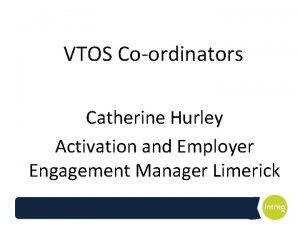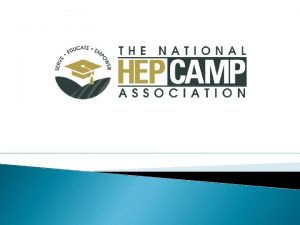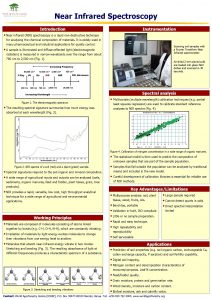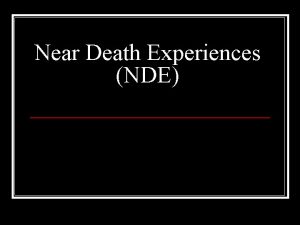VTOS in the Near Future National Association of






























- Slides: 30

VTOS in the (Near) Future National Association of VTOS Co-Ordinators National Conference: Portlaoise, 14 th April 2016 John Sweeney sweeneyecon@outlook. com 1

Outline of Presentation 1. There is ‘good news’ for programmes like VTOS in labour market trends and in national economic development strategies 2. At this stage in the recovery, the need for interventions like VTOS is intensifying – not declining - as unemployment falls 3. We now know more about best practice in how to help people who have been long-term unemployed gain decent employment 4. There are opportunities in the forthcoming national evaluation of VTOS. It is not a time for the trenches!

1. New ‘opportunities’ in labour market developments and national strategies (7) Ø The Irish economy is reaching (has passed? ) saturation point in its ‘tertiarisation’ of occupations. For a growing number enrolling in higher education, ‘past performance is no guarantee of future returns’

A third level society and becoming more so The ‘returns’ to Adult Basic Education 4

Percentage of Employment held by Graduates by Occupation. ALL OCCUPATIONS EU 15 Ireland 2007 % 2013 % 27 34 33 46 5 9 6 15 11 21 15 29 Elementary occupations EU 15 Ireland Service and Sales workers EU 15 Ireland Source: Eurostat, lfsa_egised

1. New ‘opportunities’ in labour market developments and national strategies Ø The Irish economy is reaching (has passed? ) saturation point in its ‘tertiarisation’ of occupations. For a growing number now enrolling in higher education, ‘past performance is no guarantee of future returns’ Ø Internationally trading companies are not graduate enclaves, nor do they wish to be. There is a growing interest in non-graduate recruitment streams Ø While most jobs new to the economy will require HE, most people entering new jobs will require FET. In Ireland, the significance of replacement demand is underappreciated

Skill requirements of Jobs that will be new to the economy: Job Creation, Ireland 2013 -2025 Expansion demand High qualification + 121, 000 Medium qualification + 67, 000 Low qualification - 95, 000 All qualifications + 93, 000 Cedefop (2014)

Skills requirements of Jobs that will have to be filled: Job Openings, Ireland 2013 -2015 Expansion demand Replacement demand Total Job Openings Share of Job Openings ‘ 000 s % High qualification 121 328 449 48 Medium qualification 67 311 378 40 Low qualification -95 205 110 12 All qualifications 93 843 936 100 Cedefop (2014)

Where will the Jobs come from? Private Sector Employment Growth 2014 to 2020 Groups of Sectors 2014 (benchmark) 2020 (est. ) % All Jobs Created Established Knowledge-Intensive Exporting Sectors 283, 100 345, 000 28% Employment-Intensive Domestic Sectors 893, 800 1, 000 49% Emerging ‘new’ sectors 213, 300 243, 300 14% Locally traded services 187, 000 208, 000 10% Source: Enterprise 2025, Table 5

1. New ‘opportunities’ in labour market developments and national strategies Ø The Irish economy is reaching (has passed? ) saturation point in its ‘tertiarisation’ of occupations. For a growing number now enrolling in higher education, ‘past performance is no guarantee of future returns’ Ø Internationally trading companies are not graduate enclaves, nor do they wish to be. There is a growing interest in non-graduate recruitment streams Ø While most jobs new to the economy will require HE, most people entering new jobs will require FET. In Ireland, the significance of replacement demand is underappreciated Ø In advanced countries, ‘low skilled’ jobs are not going away. Demand based on new lifestyles and changing demography is creating them in large numbers

‘Hewers of wood and drawers of water’? Types of Job Held by Young People With Less Than a Third Level Qualification, 2012 % Sales & Retail assistants, cashiers & checkout operators 29. 8 Waiters & waitresses 11. 8 Childminders & related occupations 5. 7 Bar staff 4. 6 Cleaners & domestics 3. 7 Kitchen & catering assistants 3. 3 Hairdressers, barbers, beauticians, etc. 3. 2 Shelf-fillers 2. 4 Sub-total 64. 5 Source: QNHS

New ‘opportunities’ in labour market developments and national strategies (cont. ) Ø But many ‘low skilled’ jobs are being transformed. They require rising ‘soft’ /‘transversal’ skills to be performed. They must sustain the payment of a living wage (meet a productivity imperative)

What Employers Recruiting for Non-Graduate Positions Look for 13

New ‘opportunities’ in labour market developments and national strategies (cont. ) Ø But many ‘low skilled’ jobs are being transformed. They require rising ‘soft’ /‘transversal’ skills to be performed. They must sustain the payment of a living wage (meet a productivity imperative) Ø There is an interdependence between the quality and sophistication of local services that make a region attractive (‘place making) and the dynamism of its regional economy - Enterprise 2025 Ø Ireland ‘as a small country cannot afford untapped talent [or] …to leave any of its people locked out of participating in the workforce through a lack of skills. ’ Unemployed jobseekers must be acquire skills to ‘find the best possible jobs’ Ireland’s National Skills Strategy 2025

2. The need for interventions like VTOS is intensifying, not receding, as unemployment falls v As unemployment falls, the situation of a deeply disadvantaged group is becoming more apparent

Long-Term Unemployed on the Live Register, by Duration: 2009 -2015 (‘ 000 s) 120. 0 100. 0 80. 0 60. 0 40. 0 2009 H 12009 H 22010 H 12010 H 22011 H 12011 H 22012 H 12012 H 22013 H 12013 H 22014 H 12014 H 22015 H 1 1 yr < 2 yrs < 3 yrs 3 yrs+ 16

2. The need for interventions like VTOS is intensifying, not receding, as unemployment falls v As unemployment falls, the situation of a deeply disadvantaged group is becoming more apparent v Every and any intervention on their behalf must incorporate the ability to detect and redress literacy and numeracy deficits

Adults (%) at or below Level 1 literacy/ numeracy: Ireland, 2012 Below or at Level 1 Numeracy Below or at Level 1 Literacy 30 40 26. 3 35. 8 35 25 29. 9 30 20 25 17. 2 %20 %15 15. 9 12. 1 15 10 10 5 5 0 0 Full-time employed Part-time employed Unemployed 18

Not Solved by Time Alone. Persons At or Below Level 1 - Literacy…Numeracy by Age (2012) 19

2. The need for interventions like VTOS is intensifying, not receding, as unemployment falls v As unemployment falls, the situation of a deeply disadvantaged group is becoming more apparent v Every and any intervention on their behalf must incorporate the ability to detect and redress literacy and numeracy deficits v There is no quick fix or magic bullet in moving people from long-term receipt of social welfare into sustained employment. To be successful, programmes need to: (i) motivate adults to take part; (ii) convey basic skills effectively; (iii) encourage adults to persist in the programme; and (iv) the basic skills acquired need to be sustained through use. ‘

Motivation Convey basic skills effectively Complete programme Negative perception of education CPD of instructors/ teachers Busy lives (hard to make time) Lack of awareness of benefits (not informed) Individually tailored arrangements Barriers to participation (childcare, transport, etc. ) Formative assessment Lack of belief in (for learning not of Poor course selection benefits (‘not for me’) learning) (few in networks to inform, support) Embarrassment Use skills or lose them Return to environments where skills atrophy from non-use ‘Low skills equilibria’ (frequently regional) employers and workers, with no incentive to upskill Source: Windisch (2015) “Adults with low literacy and numeracy skills: a literature review on policy intervention”, OECD.

2. The need for interventions like VTOS is intensifying, not receding, as unemployment falls v As unemployment falls, the situation of a deeply disadvantaged group is becoming more apparent v Every and any intervention on their behalf must incorporate the ability to detect and redress literacy and numeracy deficits v There is no quick fix or magic bullet in moving people from long-term receipt of social welfare into sustained employment v Encouraging people to enter low-skilled jobs because they are low-skilled (‘work first’) does not make it more likely they upskill later. Embracing lowskilled jobs for activation purposes is problematic (e. g. Pathways to Work 2016 -2020, pp 12 -13)

A challenge to the protocol between DSP and ETBs … and to Job. Path? ‘Upskilling the low-skilled long-term unemployed is a complex long-term project for which their period of unemployment can be put to good use. The process builds on the assessment of each individual’s skills and skills needs, can include validation and accreditation of existing skills and follows up with referral to a training course/ adult education, preferably including on-the-job training, supported by counselling and guidance throughout the path to stable employment. An essential ingredient for such a complex process is cooperation between employment services and private or public adult education services. ’ (European Commission SWD (2015) 176 final, p. 21. Italics added).

3. New knowledge about the hallmarks of best practice ü The right employer engagement brings multiple dividends. It supports the learners’ motivation, relevance of curricula, quality of work experience, on-the-job learning, job trials/ placement, etc. ü Sector-specific occupational training has key advantages over general employment training. Even soft skills may have a high occupation-specific element ü Foster ‘dual professionals’ who combine pedagogical expertise and occupational familiarity) ü ‘Soft skills are hard work’ ü Each barriers that endangers course completion must be identified and addressed - ‘wrap around’ services

3. New knowledge about the hallmarks of best practice (cont. ) ü Continue with ‘retention and advancement services’– maintain relationships with participants and employers for a period after the first matches have taken place. ü Carefully match learners to courses (interests, aptitudes and capabilities) to avoid disappointment to them and employers. Guidance is key, active selection is not ‘creaming’ ü Intermediaries/ brokers that liaise between employers and providers can be key – ‘translate’ employers’ skills to providers and help employers see new pools of talent

3. New knowledge about the hallmarks of best practice (cont. ) ü In raising basic adult skills, ‘successful interventions are relatively uncommon and the evaluation evidence is often weak’: o Evidence is strongest for social returns (e. g. , health and civic engagement). These are ‘meta-’ or ‘pre-’ employment o Evidence of employment impact is more scarce and primarily for younger cohorts. ‘The economic‘returns from mid-life learning are much less certain’.

3. New knowledge about the hallmarks of best practice (cont. ) o Proficiency gains are what matter – e. g. , a numeracy score higher by 54 points - one standard deviation around the Irish mean - has the same impact on earnings as additional 2. 5 years educational attainment! o Proficiency gains arise only after participation led to changes in actual practice, i. e. ‘the basic skills acquired need to be sustained through use’ e. g. minimally, reading or using maths at home; ideally, being ‘put to good use in good jobs ‘ o Proficiency gains take time to become apparent (e. g. , ca 5 -6 years according to the US LSAL)

4. Opportunities in the forthcoming national evaluation of VTOS q A timely reinforcement of the basic objectives of VTOS (including of its name!) q An evaluation for the programme and not just of it – that seeks evidence of impacts … and of how and why they occur (or do not) … integrating qualitative and quantitative findings q A time for trusting that VTOS has empower people and set processes/ dynamics under way in learners’ lives q A focus on outcomes – but outcomes that are appropriate, over time horizons that are appropriate, and linked over time (stepping stones )

4. Opportunities in the forthcoming national evaluation of VTOS (cont. ) q Anticipate and welcome evidence of diverse performance within the programme, i. e. across courses, locations – to strengthen learning and dissemination of best practice – to develop further as a network promoting excellence

Thank you!
 Future perfect simple and continuous
Future perfect simple and continuous Future perfect continuous and simple
Future perfect continuous and simple Seahawks tackling drills
Seahawks tackling drills Future continuous tense
Future continuous tense Future vs future perfect
Future vs future perfect Tenses chart for class 10
Tenses chart for class 10 Future continuous future perfect exercises
Future continuous future perfect exercises Future nurse future midwife
Future nurse future midwife Future vacation
Future vacation Verbal times
Verbal times Future plans and finished future actions
Future plans and finished future actions Future continuous vs future perfect
Future continuous vs future perfect Nulti kondicional
Nulti kondicional Hình ảnh bộ gõ cơ thể búng tay
Hình ảnh bộ gõ cơ thể búng tay Bổ thể
Bổ thể Tỉ lệ cơ thể trẻ em
Tỉ lệ cơ thể trẻ em Gấu đi như thế nào
Gấu đi như thế nào Tư thế worm breton là gì
Tư thế worm breton là gì Hát lên người ơi alleluia
Hát lên người ơi alleluia Môn thể thao bắt đầu bằng chữ f
Môn thể thao bắt đầu bằng chữ f Thế nào là hệ số cao nhất
Thế nào là hệ số cao nhất Các châu lục và đại dương trên thế giới
Các châu lục và đại dương trên thế giới Công của trọng lực
Công của trọng lực Trời xanh đây là của chúng ta thể thơ
Trời xanh đây là của chúng ta thể thơ Cách giải mật thư tọa độ
Cách giải mật thư tọa độ Phép trừ bù
Phép trừ bù độ dài liên kết
độ dài liên kết Các châu lục và đại dương trên thế giới
Các châu lục và đại dương trên thế giới Thơ thất ngôn tứ tuyệt đường luật
Thơ thất ngôn tứ tuyệt đường luật Quá trình desamine hóa có thể tạo ra
Quá trình desamine hóa có thể tạo ra




















































